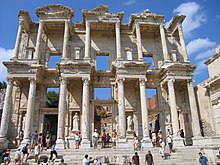Anastilosis
Anastilosis ( Greek αναστήλωσις, -εως ; from ανα, ana = "again", "back" and στηλόω = "(to put up a stele or a building)"; often also anastylosis as a derivation from ο στύλος, stylos = "the support, column “) Describes the partial reconstruction of a dilapidated ancient building using its original, preserved components.
method
The aim of the anastilosis is to bring architectural monuments back to life, the original substance of which is largely preserved in individual parts, but is no longer in a structural context. This could be caused by earthquakes or other destructive events.
The means is to get back upright in the original place. For this purpose, the original substance (stones, bricks, etc.) of the building should be used as far as possible . In cases where structures are in danger of collapsing, they can be removed stone by stone, the individual parts analyzed, numbered and cataloged and then rebuilt; sometimes on a new foundation. Additional new elements and materials ( concrete , steel girders, etc.) are only used in exceptional cases and are as "invisible" as possible, ie covered by original parts. Static reasons, i.e. in order to strengthen the structure, or the otherwise impracticable reconstruction of the original parts due to missing workpieces may make this necessary. Externally visible supplemented parts must be recognizable as such.
In the international Venice Charter 1964, the criteria of a Anastylosis have been set. First, the original appearance of the parts to be rebuilt must be fully and unequivocally determined through scientific research. Second, the original location in the structure of each component must be known. Thirdly, newly added components must be limited to what is necessary (i.e. a newly manufactured component must never be on top) and be recognizable as such. Reconstruction work in the sense of a hypothetical addition is therefore not permitted.
Examples

As the first anastilosis, the Temple of Nikes was rebuilt from its components on the Acropolis in Athens in 1836 . From 1902 Nikolaos Balanos began with the anastilosis of further buildings of the Acropolis, including the Erechtheion , the Propylaea and the correction of the anastilosis of the temple of Nikes. His work on the Parthenon was able to repair the main damage caused by the explosion of the Turkish powder magazine in 1687. His use of iron clips and dowels to connect the components, however, caused serious damage to the original material due to rust over time , so that these had to be removed and replaced with precious metal clips. Due to numerous newly identified fragments, caused by excavations and new techniques, the buildings are more complete today than 200 years before.
Dutch archaeologists used the anastilosis between 1907 and 1911 in the Buddhist temple complex Borobudur on Java . The French archaeologist Henri Marchal from the École française d'Extrême-Orient ( EFEO for short ) was introduced to the method by Pieter Vincent van Stein Callenfels and began using it in the 1930s for restoration work in Angkor . The first temple to be rebuilt in this way was the Banteay Srei .
The method of anastilosis was continuously developed in the course of the 20th century and was used in a large number of archaeological restorations around the world: from the Acropolis in Athens ( Greece ), the Odeion in Troy ( Turkey ), the Trajan sanctuary in Pergamon (Turkey ), the Temple of Heracles in Agrigento ( Italy ) to the temples in Petra ( Jordan ) and My Son ( Vietnam ). In some cases, the transition to reconstruction is fluid, for example in the very elaborate restorations of the interwar period in the former colony of Libya by Italian archaeologists, at the stage of the Theater of Sabratha or at the Arch of Severus in Leptis Magna .
It is being considered whether the Buddha statues of Bamiyan in Afghanistan , which were blown up by the Taliban in 2001 , can be re-erected in an anastilosis. Archaeologists estimate that around 50% of the debris is reusable.
literature
- Adolf Borbein , Tonio Hölscher , Paul Zanker (eds.): Classical archeology. An introduction. Reimer, Berlin 2000, ISBN 3-496-02645-6 (therein: Hans-Joachim Schalles : Archeology and Monument Preservation . P. 52 ff. Gottfried Gruben: Classic Building Research . P. 251 ff.).
- Gottfried Gruben : Anastilosis in Greece. In: Anita Rieche u. a. (Ed.): Excavation - Research - Presentation. Festschrift Gundolf Precht (= Xantener reports . Volume 12). Zabern, Mainz 2002, ISBN 3-8053-2960-1 , pp. 327-338.
- Klaus Nohlen : Anastilosis and draft. In: Istanbul communications. Vol. 54 (2004), ISSN 0341-9142 , pp. 35-54.
- Michael Petzet , Gert Mader: Practical monument preservation. Kohlhammer, Stuttgart 1993, ISBN 3-17-009007-0 , especially pp. 86 ff. And 98 ff.
- Hartwig Schmidt : Reconstruction. (= Architecture department of the German Archaeological Institute (Hrsg.): Preservation of monuments at archaeological sites. Vol. 2). Theiss, Stuttgart 1993, ISBN 3-8062-0588-4 .
- Lambert Schneider , Christoph Höcker : The Acropolis of Athens , Primus, Darmstadt 2001, ISBN 3-89678-410-2 , especially pp. 46–59.

